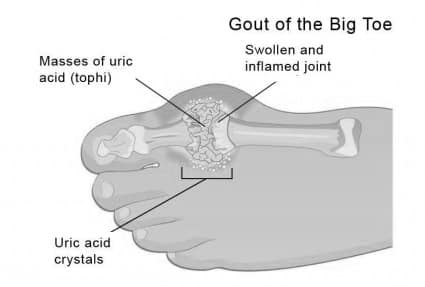
Gout - Cause, diagnosis, measures and treatment.
Gout is one of the most common forms of arthritis. Gout is caused by too much uric acid in the body. This increased presence of uric acid in the body can lead to uric acid crystals in the joints, most often in the big toe. Uric acid build-up (called tophi) that looks like small lumps under the skin.
The uric acid crystals can also lead to kidney stones due to the high level of uric acid.
Where in the body do you get gout?
Gout is an arthritis that can occur in the ankles, heels, knees, wrists, fingers, toes and elbows - but in almost all cases, the first symptoms will appear in big toe. The toe will then be very painful, sore, reddish, hot on the touch and swollen. Many patients report that the pain of the big toe can wake them up at night.
What Causes Gout?
Gout can be caused by excessive consumption of alcohol, drugs, stress or other diseases. The first uric acid attack usually heals within 3 to 10 days, even without treatment. But it is important to affirm that lifestyle changes should be made to prevent it from happening again. The next seizure may occur months or even years after the first seizure.
Risk factors for gout
You are more prone to gout if you have family history with goutis man, overweight, drinks too much alcohol, eats foods high in purines (liver, dried beans, anchovies and peas), has one enzyme defect which means you can't break down purines in a good enough way is exposed to too much lead in your local environment, have had one organ transplant, takes the vitamin niacin or if you are taking the medication aspirin, levodopa (Parkinson's medicine), cyclosporine or diuretic.
RELATED PRODUCT / SELF-HELP: - Compression sock
Anyone with foot pain and problems may benefit from compression support. Compression socks can contribute to increased blood circulation and healing in those affected by reduced function in the legs and feet.
Click on the image to read more about these socks.
How is the diagnosis of gout?
The clinician will first take a history that includes medical history and familial conditions. Signs of gout include: Hyperturicemia (high levels of uric acid in the blood), uric acid crystals in synovial fluid, arthritis that occurs during a day and in a single joint - for example the big toe.
How is gout treated?
Gout can be treated with NSAIDS, corticosteroids or colchicine. There are also medications that can lower blood uric acid levels.
Prevention of gout
Make sure you have a healthy, balanced diet. Avoid eating too much food that contains a lot of purines and drink well with water. Exercise regularly and maintain a good body weight, because overweight has a higher risk of gout.
NEXT PAGE: This You Should Know About Rheumatism
Click on the image above to proceed to the next page.



Leave a reply
Want to join the discussion?Feel free to Contribute!